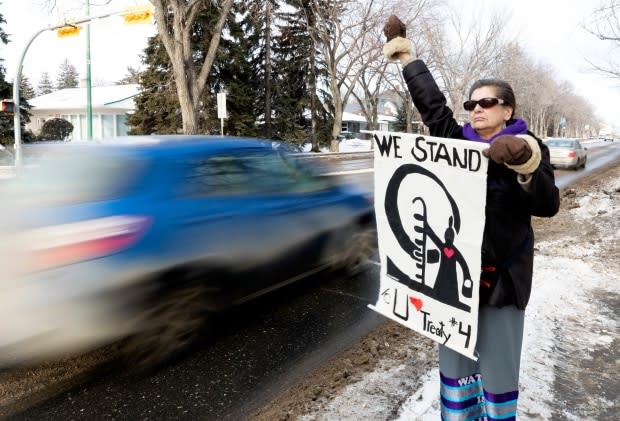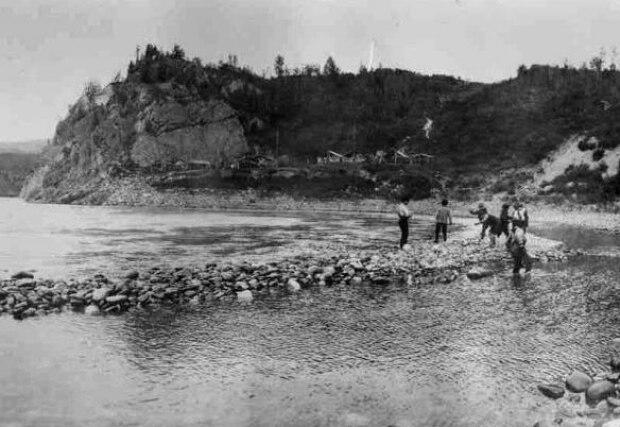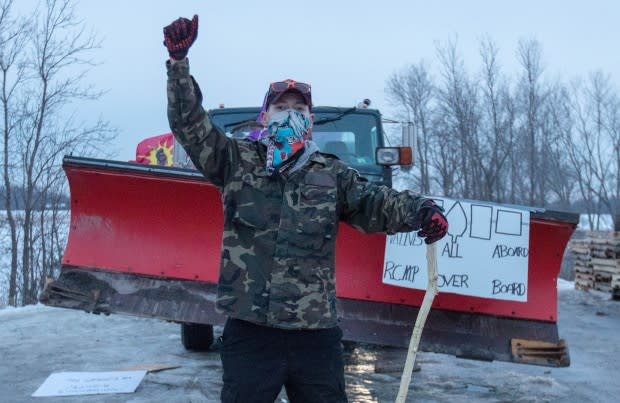Pipeline approval record reveals conflict with Wet'suwet'en years in the making
A battle between the hereditary chiefs of a B.C. First Nation and a company planning to build a natural gas pipeline through their territory in the northwest of the province has exploded into the Canadian consciousness with cross-country protests.
Rail blockades that began earlier this month in opposition to the project have crippled the country's transportation network, but the paper trail behind Coastal GasLink's pipeline approval reveals a conflict years in the making.
The root of the current clash can be found in reasons given for an environmental assessment certificate issued by B.C.'s ministers of environment and natural gas development on Oct. 23, 2014.
The province acknowledged concerns from the Office of the Wet'suwet'en hereditary chiefs and other Indigenous groups — and gave the green light to the project anyway.
The very next entry in the B.C. Environmental Assessment Office (EAO) approval record is a Wet'suwet'en "title and rights" report that same year telegraphing the tensions that would block railroads and ports more than five years later.
It concludes that the chiefs can't rely on the province, the EAO or the company behind the project — TransCanada — and its technology "to somehow protect our aboriginal title."
And they draw on a string of broken promises from the time "the first white settler fenced" their lands to the establishment of B.C.'s biggest silver mine in Wet'suwet'en territory and onward.
"The promises have continued, but the devastation of our lands and resources have continued without any long lasting protection and agreement with the Crown," the report said.
'Issues, concerns and interests'
The EAO record of the Coastal GasLink project contains thousands of pages of documents filed in relation to the proposal to build the 650 km natural gas pipeline from the community of Groundbirch, 40 km west of Dawson Creek, to LNG Canada's liquefied natural gas export facility near Kitimat.
The company's initial project description was filed in October 2012.

It promised to "build and maintain positive long-term relationships" with potentially affected Indigenous groups, ensure that "input and concerns are gathered, understood and integrated" and to "ensure that concerns and issues with respect to environmental or socio-economic effects ... are addressed, as appropriate."
Although the project ultimately gained the support of 20 elected band councils along the route, the office of the hereditary Wet'suwet'en chiefs has never wavered in its objections.
The first Aboriginal Consultation report, filed in May 2013, details 31 categories of "issues, concerns and interests" ranging from the potential for adverse effects on fisheries, wildlife and water and air quality to concerns about fracking, caribou, medicinal plants and confidentiality around the sharing of traditional knowledge.
'Lack of capacity, funding and expertise'
Notes filed from a regional meeting held in Prince George in November 2013 give a sense of the challenges facing all First Nations when it comes to environmental assessments and the multitude of companies like TransCanada looking to satisfy requirements for projects.
"There is a lack of capacity, funding and expertise in First Nations to meet what is required," reads one comment.
"We are inundated by requests: letters, meetings, funding proposals. How do we engage to meet these timelines? We don't want to miss the opportunity to intervene and disagree."

Representatives from a dozen First Nations attended that meeting, including the Wet'suwet'en First Nation — a Burns Lake-area band of around 300 people that is a different entity from the Office of the Wet'suwet'en hereditary chiefs. One of the questions was whether the meeting itself was considered consultation.
"There are different levels of consultation," was the response.
"The courts have found that government does not clarify process very well, so this session is designed to clarify and to hear concerns and have a follow up. This is part of the consultation process, but it is too narrow to be enough to fulfil our entire duty to consult."
'Life and death' for Wet'suwet'en
The Office of the Wet'suwet'en sent EAO manager Brian Westgate a letter in April 2014, six months before the office gave a green light to the pipeline.
At that time, Wet'suwet'en environmental co-ordinator Mike Ridsdale wrote that they considered the pipeline application "incomplete."

"It does not contain sufficient information specific to Wet'suwet'en cultural needs, and it does not consider the specific impacts to Wet'suwet'en territories, which also impacts Wett'suwet'en rights," Ridsdale wrote.
"The potential for significant adverse impacts upon the Wet'suwet'en environment, culture and constitutionally protected rights is real."
The EAO responded, citing spreadsheets of data collected to allay the fears of the hereditary chiefs.
But three weeks before the province gave the project ministerial approval, Ridsdale wrote again, complaining that the company's data lacked "complexity, value and significance" to speak to issues that were "life and death" for the Wet'suwet'en.
Ridsdale claimed the "lack of information" was "an injustice to the Wet'suwet'en people" saying that the significance and magnitude of the pipeline's potential effects couldn't be determined because of the weakness of the information.
"How can the Wet'suwet'en have any assurance of the protection of our values, when the supplied 'conditions' do not acknowledge Wet'suwet'en title, rights and associated interests of our territories?" he asked.
Obligations 'fulfilled'
The assessment moved ahead regardless — and five days later the EAO gave the pipeline its recommendation.
That document concludes with a section "weighing impacts on Aboriginal interests with other interests."
It said natural gas projects "have the potential to bring tens of billions of dollars in investment to British Columbia between 2014 and 2022."
The EAO conceded that "traditional subsistence activities such as hunting, fishing, gathering and trapping may be altered," but said the potential for adverse effect on the Aboriginal rights "has been avoided, minimized or otherwise accommodated to an acceptable level."
And so they concluded that the provincial Crown "had fulfilled its obligations for consultation."

